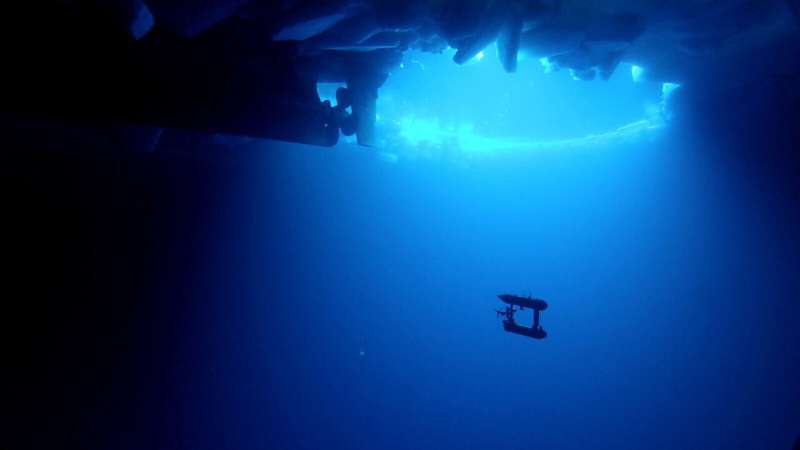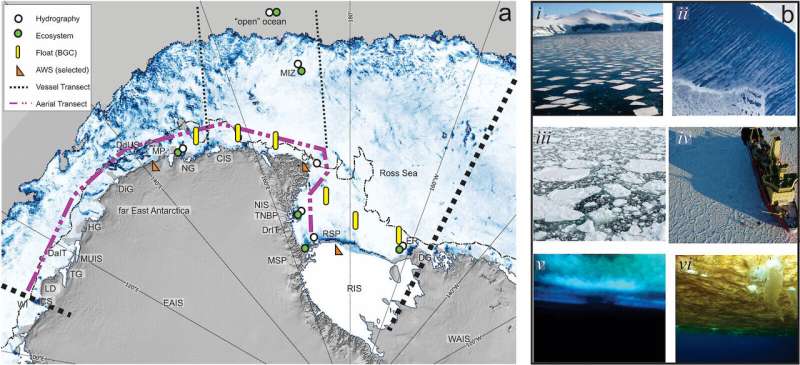This article has been reviewed according to Science X's editorial process and policies. Editors have highlighted the following attributes while ensuring the content's credibility:
fact-checked
peer-reviewed publication
proofread
New Antarctic observing system proposed

Scientists have proposed a new ocean–sea ice–atmosphere observing system between the Ross Sea and Casey station, to monitor changes in this understudied part of Antarctica's ice-covered marine environment.
Australian Antarctic Program sea-ice scientist Dr. Petra Heil, and atmospheric scientist Dr. Simon Alexander, along with colleagues from New Zealand and Korea, reviewed recent studies in the region, and its governance requirements, to help refine the focus and design of a Ross Sea-far East Antarctic Region (RSfEAR) observing system.
"Polar processes are critical in shaping Earth's climate and ecosystems. But our understanding of the interactions between the Antarctic ocean, sea ice and atmosphere, and their role in the Earth's physical, chemical and biological processes is incomplete, especially near the coast where glaciers meet the sea ice and ocean," Dr. Heil said.
"While there have been repeat or long-term studies at some Antarctic locations, the region in the far East Antarctic and Ross Sea is largely understudied and poorly observed.
"This region connects a number of ice shelves and areas of open water known as 'polynyas,' which promote sea-ice growth and underpin a diverse and rich ecosystem."
Writing in Frontiers in Marine Science this month, the research team proposed a range of observing initiatives based on existing activities, knowledge gaps and future needs.
The observing system should include:
- moored oceanographic instruments to study ocean chemistry and physics
- remote sensing technologies on satellites, aircraft, drifting buoys and autonomous underwater vehicles, for sea-ice and ecosystem monitoring
- automatic weather stations on land and at sea
- integration of observations in models
"Once rolled out and refined, RSfEAR will provide the backbone to extend deeper onto the continent and further out to sea, for a full longitudinal Antarctic-Southern Ocean observatory," Dr. Heil said.

East Antarctic monitoring program
The proposed RSfEAR will complement and extend a new East Antarctic Monitoring Program (EAMP) being developed by the Australian Antarctic Division.
EAMP Leader, Dr. Patricia Miloslavich, said the EAMP would provide situational awareness of East Antarctica and the Southern Ocean through long-term scientific observations of essential climate, ocean, and biodiversity variables in the region.
"The EAMP will address major unknowns and uncertainties that currently hinder our capacity for forecasting, prediction, management, and attribution of impacts on what is changing and why," Dr. Miloslavich said.
"It will also facilitate coordination of different research disciplines and better integration of data collection, analysis and reporting."
Improved coverage of observations across Antarctica and across different scientific disciplines will help scientists understand recent extreme events and their trajectory.
These events include the lowest winter sea-ice extent on record (since 1979) in September 2023—some 1.75 million square kilometers below the 1981–2010 average maximum extent.
In March 2022, surface temperatures in Antarctica rose by more than 30°C relative to the long-term average, due to an "atmospheric river" carrying warm air masses deep into the continent.
Later the same year a breakout of near-coastal fast ice (sea ice anchored to the continent or seafloor) led to a near complete breeding failure of emperor penguins in the Bellingshausen Sea.
"Given the recent extremes in Antarctic sea-ice extent, as well as record ice-sheet melting, changes in ocean salinity and temperature, and atmospheric changes, a better observational capability will improve our ability to predict future climate change." Dr. Heil said.
"It will also provide a foundation to assess and measure impacts for ecosystems and distant, low-latitude regions."
More information: Petra Heil et al, Bridging the gap for ice–ocean–ecosystem processes: integrated observing system for the Ross Sea-far East Antarctic Region, Frontiers in Marine Science (2023). DOI: 10.3389/fmars.2023.1206119
Journal information: Frontiers in Marine Science
Provided by Australian Antarctic Program




















